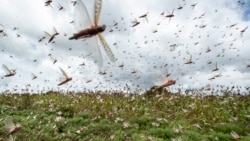Swarms of locusts have destroyed large areas of farmland and are threatening food security in East Africa.
Kenya is reporting its worst locust outbreak in 70 years. Billions of the insects have already destroyed tens of thousands of hectares of plant life across the country.
Record locust outbreaks have also been reported in Ethiopia and Somalia. The insects have also attacked parts of Sudan, Djibouti and Eritrea. The United Nations Food and Agriculture Organization, or FAO, is calling it East Africa’s worst desert locust invasion in 25 years.
In Somalia, the government declared a national emergency because of locusts. It said the outbreak was presenting a “major threat” to the already weakened food security situation.
Airplanes have been releasing chemical pesticides to control the locust population. But officials have said they have limited money and equipment to fight the insects in affected areas.
UN officials have said they are worried that the swarms could spread to Uganda and South Sudan. They estimate that $76 million is needed now to widen efforts aimed at preventing further spread across East Africa.
The desert locusts – which grow to be about as long as a person’s finger - produce young very quickly. They fly in large groups in search of food.
The Intergovernmental Authority on Development, or IGAD, an East African group, reports that locust swarms can contain up to 150 million locusts per square kilometer. It noted that “the swarms migrate with the wind and can cover 100 to 150 kilometers in a day.”
An average swarm could destroy the same number of food crops in a day as could feed 2,500 people, the group added.
UN officials have warned that if the extreme outbreaks are not controlled, the number of locusts could grow 500 times by June.
Last December, Somalia suffered a locust outbreak that destroyed about 100,000 hectares of farmland. Government officials have warned that a second invasion will be even more destructive.
The current outbreaks followed one of the wettest years on record in East Africa. Heavy rainfall and warmer temperatures help the locust population grow.
Officials from the FAO say that even before the locust invasions, about 11 million people were experiencing food insecurity in Ethiopia, Somalia and Kenya.
“Therefore, we need to make all possible efforts to avoid such a deterioration,” said FAO official Dominique Burgeon. He spoke to a Reuters news agency reporter after visiting two affected areas in Kenya.
In Somalia, conflict and instability issues have made pesticide spraying operations difficult, the FAO noted in December. In northern Kenya, five planes were releasing chemicals to fight the outbreak, The Associated Press reported.
Marcus Dunn is a pilot and the director of Farmland Aviation, a company which uses airplanes to drop pesticides and fertilizer on farmland. He told The AP the five planes should be enough to look over this part of northern Kenya for now.
However, he said if the locust problem increases in other parts of the country, “we are going to need some more assistance, because we just don’t know how big this problem is going to be.”
I’m Bryan Lynn.
Bryan Lynn wrote this story for VOA Learning English, based on reports from The Associated Press, Reuters and VOA News. George Grow was the editor.
We want to hear from you. Write to us in the Comments section, and visit our Facebook page.
_________________________________________________________________
Words in This Story
swarm – n. a large group of things, usually insects, moving together
outbreak – n. a sudden or violent increase in activity; a rise in disease infection rates
pesticide – n. a chemical used to kill insects
migrate – v. to move from place to place
deterioration – n. the process of becoming progressively worse
instability – n. a lack of security











